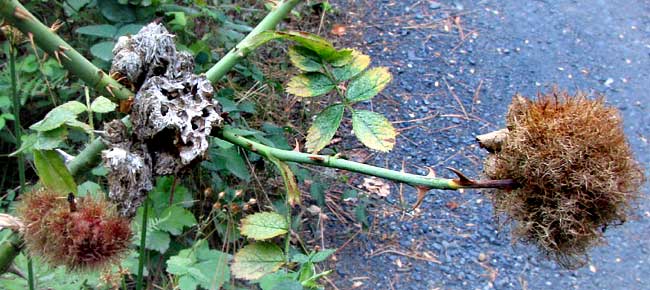Excerpts from Jim Conrad's
Naturalist Newsletter

from the October 4, 2009 Newsletter, issued from the Siskiyou Mountains west of Grants Pass, Oregon:
MOSSY ROSE GALL
Along the gravel road leading up from the valley some "wild rose" bushes have the growths on them shown above. This is the road I jog each morning so I've been watching the growths form for months, slowly enlarging and passing through several color stages. The big one on the right is a little larger than a golf ball. The whitish mess at the left is what's left of last year's edition of the same thing. You've probably guessed that they're galls. As in the case with most but not all galls, female insects caused them when they inserted their eggs into the plant resulting in tumorous growth around the eggs, and eventually the gall. Larvae from the eggs will eat the gall's relatively soft tissue, then metamorphose.
Thousands of insect kinds form galls on thousands of kinds of plant, and typically each insect has a specific plant or kind of plant it bestows with its galls, and each insect/plant combination produces a characteristic gall. In the present case the host plant is the Sweetbrier Rose, and the 0.16-inch long (4 mm) insect causing the gall is a member of a group of tiny wasps called gall wasps. Sometimes the species is known as the Bedeguar Gall Wasp; it's DIPLOLEPIS ROSEA. You can see from the species name that it specializes in roses.
The gall itself is eye-catching enough to have several names, including Mossy Rose Gall, Bedeguar Gall and Robins pincushion. The galls once were used medicinally against colic and as a diuretic.